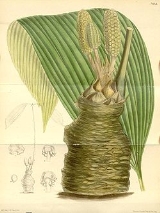
Zamia wallisii
Encyclopedia
Zamia wallisii is a species of plant
in the Zamiaceae
family. It is endemic to Colombia
. It is threatened by habitat loss.
from material collected by Gustav Wallis
in Colombia
. The species was collected once again in 1888 by Guillermo Kalbreyer
and then not seen again for 100 years. Both the Wallis and Kalbreyer collections were lost and no type specimen was extant resulting in some doubt about the existence of the species until its rediscovery in the 1980s.
Plant
Plants are living organisms belonging to the kingdom Plantae. Precise definitions of the kingdom vary, but as the term is used here, plants include familiar organisms such as trees, flowers, herbs, bushes, grasses, vines, ferns, mosses, and green algae. The group is also called green plants or...
in the Zamiaceae
Zamiaceae
The Zamiaceae are a family of cycads that are superficially palm or fern-like. They are divided into two subfamilies with eight genera and about 150 species in the tropical and warm temperate regions of Africa, Australia and North and South America....
family. It is endemic to Colombia
Colombia
Colombia, officially the Republic of Colombia , is a unitary constitutional republic comprising thirty-two departments. The country is located in northwestern South America, bordered to the east by Venezuela and Brazil; to the south by Ecuador and Peru; to the north by the Caribbean Sea; to the...
. It is threatened by habitat loss.
History
Zamia wallisii was described in 1875 by Alexander BraunAlexander Braun
Alexander Carl Heinrich Braun was a German botanist from Regensburg, Bavaria.He studied botany in Heidelberg, Paris and Munich. In 1833 he began teaching botany at the Polytechnic School of Karlsruhe, staying there until 1846...
from material collected by Gustav Wallis
Gustav Wallis
Gustav Wallis was a German plant collector, who introduced over 1,000 plant species to Europe, many of which were named after him.-Early life:...
in Colombia
Colombia
Colombia, officially the Republic of Colombia , is a unitary constitutional republic comprising thirty-two departments. The country is located in northwestern South America, bordered to the east by Venezuela and Brazil; to the south by Ecuador and Peru; to the north by the Caribbean Sea; to the...
. The species was collected once again in 1888 by Guillermo Kalbreyer
Guillermo Kalbreyer
Wilhelm Kalbreyer was a German plant collector who was sent by James Veitch & Sons of Chelsea, London to collect new plants in West Africa and South America....
and then not seen again for 100 years. Both the Wallis and Kalbreyer collections were lost and no type specimen was extant resulting in some doubt about the existence of the species until its rediscovery in the 1980s.
Sources
- Donaldson, J.S. 2003. Zamia wallisii. 2006 IUCN Red List of Threatened Species. Downloaded on 24 August 2007.
External links
- http://plantnet.rbgsyd.nsw.gov.au/cgi-bin/cycadpg?taxname=Zamia+wallisiiZamia wallisii on The Cycad Pages (Royal Botanic Gardens, SydneyRoyal Botanic Gardens, SydneyThe Royal Botanic Gardens in Sydney, Australia, are the most central of the three major botanical gardens open to the public in Sydney....
)]

